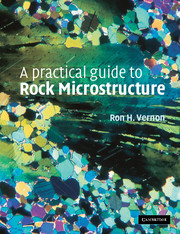Book contents
5 - Microstructures of deformed rocks
Summary
Rocks are commonly subjected to tectonic deformation, with the result that they undergo a change of shape (strain), producing deformed rocks known as tectonites. Knopf (1931, p. 7) translated the original definition of tectonites (Sander, 1911, 1930) as ‘metamorphic rocks deformed by differential movements that integrate into the tectonic movement as a whole’. In this definition, the word ‘metamorphic’ should be extended to include deformed rocks that undergo only small degrees of alteration. This involves rocks that many people would call ‘diagenetic’ (Section 2.2.7), there being a gradation between ‘burial metamorphism’ and diagenesis (see, for example, Vernon, 1976). The type and amount of strain depend on both the local directed pressure (non-hydrostatic stress; deviatoric stress) and the mechanical properties of the rock. The detailed, quantitative study of strain is a complex topic that is outside the scope of this book.
The aims of structural geology are to infer the deformation conditions from the structures in the rocks, observed both in the field and with the microscope, and to relate the deformation to the timing and nature of metamorphism. These can be difficult and complicated problems, and much has been written on them. Therefore, I will not try to be comprehensive, but will emphasize the more petrologically related aspects of deformation-related microstructures and the processes by which they are formed.
- Type
- Chapter
- Information
- A Practical Guide to Rock Microstructure , pp. 295 - 474Publisher: Cambridge University PressPrint publication year: 2004
- 3
- Cited by



